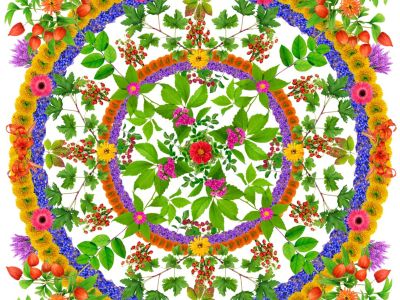What is a Mandala Garden?
By definition, a mandala is “a geometric shape or pattern that symbolizes the universe; a meditation tool for creating sacred spaces, relaxation, and focusing the mind; or a symbol used as a gateway to a spiritual journey.” Mandalas are usually a circle that contain starburst, floral, wheel, or spiral patterns within it. A mandala garden is simply a garden space with plants that take on this design principle. Traditional mandalas were actually a square containing a circle which contained these patterns. Also, in traditional mandalas, the four directions (north, east, south, and west) or the four elements (earth, air, fire, and water) were often represented in the mandala pattern.
Mandala Garden Design
By building a mandala garden, you create a sacred space for quiet reflection and meditation. As stated above, mandalas are generally circular with patterns inside. Mandala gardens are also created as circular gardens and the inner patterns are created by paths and plant beds. A simple mandala garden design may just consist of paths that run through the circle like spokes on a bicycle wheel. The wedge-shaped beds between spoke paths would then be filled with aesthetic and aromatic plants. Ideally, the plants in mandala gardens are small and easily accessible so that each plant can be easily maintained from the paths. Common plants in mandala gardens include:
Dianthus Gaura Chamomile Catmint Lavender Yarrow Sedum Thyme Bee balm Sage Rosemary Alyssum
Herbs of any kind make excellent additions to mandala gardens. They have also been created using vegetables or just aesthetically pleasing plants. What you put in your mandala garden should be based on your own preferences – what plants make you feel happy and peaceful? These are the plants you’ll want to add to a do-it-yourself mandala garden.
DIY Mandala Gardens
Mandala garden design will depend on the space you have and your budget. Mandala gardens can be huge and filled with elaborate curved or spiral paths. They can include a seating or meditation area. Many times, large mandala gardens will have a water feature in the center to bring the calming sound of rushing water to the sanctuary. Usually, a lawn for meditation or a seating area is located near the water feature. Not all of us have room for a large elaborate mandala garden. Small mandala gardens can still feel like a secluded, sacred space by ringing them with tall grasses, columnar shrubs, or evergreens. Again, depending on your preference and/or budget, mandala garden paths can be made with sand, pebbles, bricks, or tiles, and plant beds can be edged with plastic edging, large stones, bricks, or concrete edgers. Plant beds can be filled with mulch or rock. You can add extra flair to wheel-patterned mandala garden designs by alternating different colors of rock and mulch.
